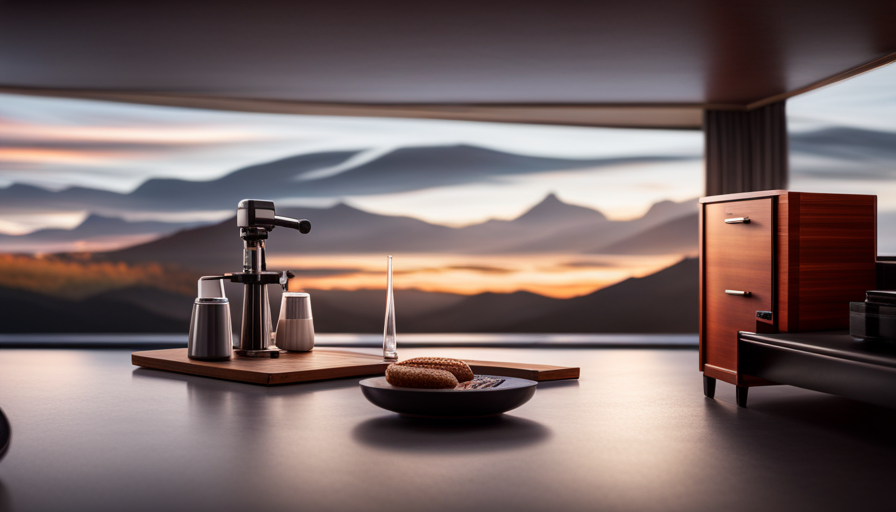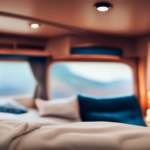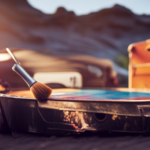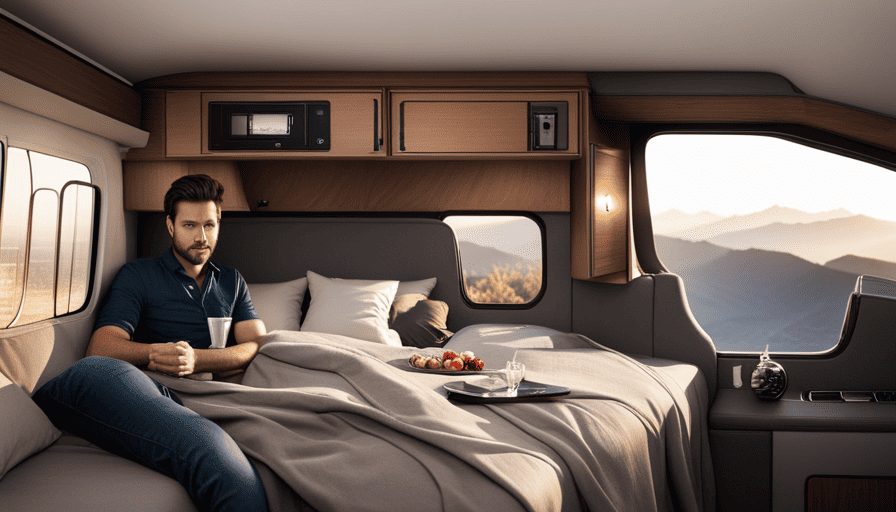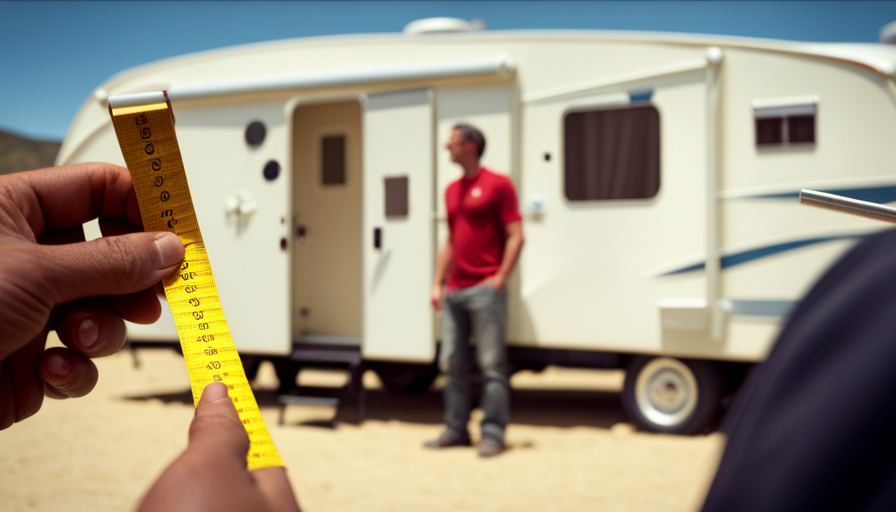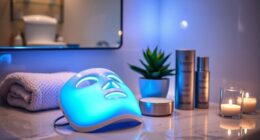Hello, fellow explorers! Are you prepared to update the appearance of your camper cabinets? You’re in luck! In this article, I will be revealing my reliable method for painting camper cabinets.
Now, I know what you’re thinking – why bother with the hassle of painting when you could just replace them? But trust me, a little paint can work wonders and completely transform the look of your camper. Plus, it’s a budget-friendly option that allows you to put your own personal touch on your home away from home.
Before we dive into the step-by-step process, let’s make sure you have everything you need. From assessing the condition of your cabinets to gathering your supplies, prepping, priming, and finally painting, I’ll guide you through each stage.
And don’t worry, I’ll also share some tips for maintenance and care to keep your cabinets looking their best for many adventures to come. So, let’s get started and give your camper cabinets the makeover they deserve!
Key Takeaways
- Assess the condition of the cabinets and make necessary repairs before painting
- Gather supplies: primer, sandpaper, painter’s tape
- Remove cabinet doors, drawers, and hardware for easier painting
- Apply paint using brush or roller in thin, even coats
Assess the Condition of Your Cabinets
Before you start painting, take a moment to assess the condition of your camper cabinets. Assessing techniques will help you determine the necessary steps to achieve a successful paint job.
Begin by examining the surface of the cabinets for any cracks, dents, or peeling paint. If you notice any of these issues, it’s crucial to repair them before proceeding with painting. Fill in the cracks and dents using a wood filler and sand down any rough edges.
Next, check the overall stability of the cabinets. Ensure that they’re securely attached to the walls and that there are no loose hinges or handles. If you find any loose parts, tighten them or replace them if necessary.
Finally, evaluate the cleanliness of the cabinets. Remove any dirt, grease, or grime by wiping them down with a mild cleaner and a damp cloth.
Once you’ve assessed the condition of your cabinets, you can move on to the next step, which is gathering your supplies needed for the painting process.
Gather Your Supplies
First, make sure you’ve got all your tools and materials ready so you can dive right into transforming your camper cabinets! To assess your materials, check if you have enough primer to cover all the cabinets. You’ll also need sandpaper with a grit of 120 or higher to prep the surface. Additionally, gather painter’s tape to protect the surrounding areas from accidental paint splatters.
Once you have all these supplies, it’s time to choose the perfect colors for your camper cabinets. Consider the overall theme or style you want to achieve. Light colors like white or pastels can make the space feel bright and airy, while darker shades like navy or gray can create a more modern and cozy atmosphere. Don’t be afraid to experiment with bold colors or patterns to add a unique touch to your camper interior.
Now that you have assessed your materials and chosen your colors, it’s time to move on to the next step: prepping your cabinets.
Prep Your Cabinets
Before I can start painting my camper cabinets, I need to properly prepare them. First, I’ll remove all items from the cabinets and give them a thorough cleaning to ensure a fresh surface for the paint.
Next, I’ll take off the cabinet doors, drawers, and hardware, as this’ll make it easier to paint and ensure a professional-looking finish.
Finally, I’ll sand the surfaces to create a smooth and paintable finish, allowing the new paint to adhere properly. By following these steps, I’ll ensure that my camper cabinets are ready for a stunning transformation.
Remove all items from the cabinets and clean them thoroughly
To give your camper cabinets a fresh new look, start by clearing out all your belongings and giving them a nice deep cleaning. Assess the damage on each cabinet, checking for any dents, scratches, or loose hinges. This will help you determine the amount of prep work needed. Next, choose your paint colors. Consider the overall theme and style of your camper, as well as any existing color schemes. A popular choice is to go with a light and bright color to make the space feel larger and more open. Alternatively, you can opt for a bold and vibrant color to add a pop of personality. Once you’ve assessed the damage and chosen your colors, it’s time to remove the cabinet doors, drawers, and hardware. This will make the painting process much easier and ensure a professional-looking finish.
Remove cabinet doors, drawers, and hardware
Once you’ve cleared out your belongings, it’s time to get hands-on and start removing those cabinet doors, drawers, and hardware for a seamless and professional-looking renovation.
Assess the condition of each cabinet element, checking for any damages or repairs needed. This is the perfect opportunity to inspect the hinges, handles, and pulls, replacing any worn-out or outdated hardware.
Next, choose your paint colors carefully, considering the overall aesthetic of your camper and the desired look you want to achieve. Opt for colors that complement your interior design and create a cohesive atmosphere.
After removing the doors, drawers, and hardware, transition into the subsequent section about sanding the surfaces to create a smooth and paintable finish.
Sand the surfaces to create a smooth and paintable finish
Sandpaper is an essential tool for achieving a smooth and paintable finish. The most commonly used option is 80-grit sandpaper. Here are some discussion ideas to help you sand your camper cabinets effectively:
-
Choosing the right sandpaper grit: Consider the condition of your cabinets and the level of roughness you want to remove. If the surface is in good condition, start with a finer grit like 120 or 150. For more significant imperfections, begin with 80-grit and gradually work your way up to finer grits.
-
Techniques for achieving a smooth finish: Use long, even strokes with the sandpaper, following the wood grain. Apply gentle pressure and avoid sanding too aggressively, as it can damage the surface. Take your time and periodically check the smoothness of the surface with your hand.
-
Clean and smooth the edges: Pay attention to the edges and corners of the cabinets, as they may require extra sanding to achieve a uniform finish.
-
Remove dust before painting: Once you have finished sanding, wipe down the surfaces with a tack cloth or a damp cloth to remove any dust particles.
Now, it’s time to prime your cabinets for painting.
Prime Your Cabinets
To ensure better paint adhesion and coverage, I always make sure to apply a primer on my camper cabinets.
I use a brush or roller to apply the primer evenly, making sure to cover all surfaces.
It’s important to allow the primer to dry completely before moving on to the next step, as this’ll ensure a smooth and durable paint finish.
Apply a primer to ensure better paint adhesion and coverage
First, make sure to apply a primer to your camper cabinets in order to achieve optimal paint adhesion and coverage. Applying a primer is essential as it creates a smooth surface for the paint to adhere to, resulting in a professional finish that will last.
The primer also helps to seal any imperfections or stains on the cabinets, ensuring that they’re not visible after painting. It’s important to choose a primer specifically designed for painting cabinets, as it’ll provide better adhesion and coverage.
To apply the primer, use a brush or roller and work in even strokes, covering the entire surface of the cabinets. This’ll ensure that the primer is applied evenly and that all areas are properly coated.
With the primer applied, you’re now ready to move on to the next step of painting your camper cabinets.
Use a brush or roller to apply the primer evenly
For a flawless and professional finish, effortlessly glide your brush or roller over the surface, ensuring every inch is evenly coated with primer.
When it comes to applying primer to camper cabinets, you have the option of using either a brush or a roller. Each tool has its advantages, so choose the one that best suits your preferences and the size of the cabinets.
A brush allows for more precision and control, making it ideal for smaller areas and intricate details. On the other hand, a roller covers larger surfaces quickly and efficiently, saving you time and effort.
Whichever tool you choose, make sure to apply the primer in thin, even coats to achieve optimal adhesion and coverage. Once you’ve completed this step, allow the primer to dry completely before moving on to the next phase.
Allow the primer to dry completely before moving on to the next step
Once the primer has fully dried, you can proceed to the next phase. Drying time is crucial to ensure a smooth and durable finish on your camper cabinets. It is important to follow the manufacturer’s instructions on the primer label to determine the exact drying time needed. Typically, it takes around 24 hours for the primer to dry completely, but this may vary depending on factors such as humidity and temperature. While waiting for the primer to dry, you can use this time to plan your painting techniques. Consider whether you want to use a brush or a roller for the best application. A brush allows for more control and precision, while a roller covers larger areas quickly. Once the primer is dry, you are ready to paint your cabinets and give them a fresh new look.
To proceed with painting your cabinets, refer to the next section about ‘paint your cabinets’ for detailed instructions.
Paint Your Cabinets
Transforming your camper cabinets with a fresh coat of paint will breathe new life into your space.
When it comes to painting your cabinets, there are a few important steps to consider. First, take some time to explore different color options that’ll complement the overall aesthetic of your camper. Consider the style and theme you want to achieve and choose a paint color that aligns with your vision. Next, it’s important to properly clean and sand the cabinets before painting to ensure the best adhesion and finish. Additionally, consider using a high-quality primer to help the paint adhere and provide a long-lasting finish. These camper makeover tips will help you achieve a professional-looking result that will enhance the overall atmosphere of your space.
Additionally, it’s crucial to choose the right type of paint for your cabinets. Opt for a high-quality, durable paint that’s specifically designed for use on cabinets. This’ll ensure that the paint adheres well and withstands the wear and tear of camping adventures.
Before you begin painting, make sure to thoroughly clean and sand your cabinets to create a smooth surface for the paint to adhere to. Then, apply a primer to promote better adhesion and longer-lasting results.
After the primer has dried completely, it’s time to paint your cabinets. Use a brush or roller to apply the paint evenly, working in long, smooth strokes. Allow the first coat to dry, and then apply a second coat for optimal coverage.
In the next section, we’ll explore how to add finishing touches to your freshly painted camper cabinets, such as replacing hardware and adding decorative accents.
Add Finishing Touches
Enhance the overall look of your camper space by adding the perfect finishing touches to your newly painted cabinets. Here are some ideas to inspire you:
-
Decorative Hardware: Choose hardware that complements the style of your camper. From sleek and modern to rustic and vintage, there are endless options to choose from. Consider knobs, pulls, and hinges in various finishes such as brushed nickel, brass, or black matte. These small details can make a big impact on the overall aesthetic of your cabinets.
-
Color Options: Don’t be afraid to get creative with color! Consider adding a pop of color with brightly colored hardware or opting for a contrasting color for your cabinet doors. If you prefer a more subtle look, choose hardware that matches the color of your cabinets for a cohesive and polished appearance.
-
Accessorize: Once your cabinets are painted and hardware is installed, it’s time to accessorize! Add some decorative items such as plants, candles, or small artwork to the top of your cabinets. This will add personality and style to your camper space.
By adding decorative hardware and choosing the right color options, you can transform your camper cabinets into a true reflection of your personal style. With the finishing touches complete, it’s time to allow the paint to cure and move on to the next step.
Allow the Paint to Cure
Now that you’ve added the perfect finishing touches, it’s time to let the paint fully cure, allowing your newly transformed camper space to truly come to life. The curing time and drying process are crucial steps in achieving a durable and professional-looking finish. It’s important to follow the manufacturer’s instructions for the specific type of paint you used, as different paints may have different curing times.
During the curing process, the paint chemically bonds to the surface, resulting in a strong and long-lasting finish. This process typically takes anywhere from a few days to a few weeks, depending on factors such as humidity and temperature. It’s essential to give the paint enough time to fully cure before subjecting it to any heavy use or cleaning.
To help you keep track of the curing time, here’s a simple table outlining the average drying times for different types of paint:
| Type of Paint | Drying Time |
|---|---|
| Latex | 1-2 hours |
| Oil-based | 6-8 hours |
| Chalkboard | 24 hours |
Once the paint has fully cured, you can move on to the next step: maintenance and care. This will ensure that your newly painted camper cabinets stay in great condition for years to come.
Maintenance and Care
When it comes to maintaining and caring for your freshly painted camper cabinets, it’s important to establish a regular cleaning routine. I recommend using gentle cleaners and a soft cloth to wipe down the surface. Make sure not to use abrasive materials or harsh chemicals that could potentially damage the paint.
Additionally, it’s crucial to keep an eye out for any chips or scratches and promptly touch them up as needed. This will help maintain the overall appearance of your beautifully painted cabinets.
Clean your cabinets regularly with gentle cleaners and a soft cloth
To maintain the beauty of your camper cabinets, make sure you regularly clean them with gentle cleaners and a soft cloth, as the saying goes, "A clean cabinet is a happy cabinet."
When it comes to cabinet cleaning tips, using gentle cleaners is essential to prevent any damage to the paint. I recommend using mild dish soap diluted in warm water or a non-abrasive all-purpose cleaner. These cleaners are effective in removing dirt and grime without causing any harm.
Simply dampen a soft cloth with the cleaner and gently wipe down the cabinets, paying attention to any stubborn spots. Remember to always follow the manufacturer’s instructions for any specific cleaner you choose.
Avoid using abrasive materials or harsh chemicals that could damage the paint.
Transitioning into the subsequent section, it’s important to know how to avoid any potential harm to your cabinets.
Avoid using abrasive materials or harsh chemicals that could damage the paint
Keep in mind that using rough materials or strong chemicals on your beloved camper’s storage spaces could potentially cause harm, so it’s best to steer clear of them.
When it comes to painting your camper cabinets, choosing the right paint color and using the proper techniques is crucial. Start by selecting a paint color that complements the overall aesthetic of your camper. Consider lighter shades to create a spacious feel or darker tones for a cozy ambiance.
Prep the cabinets by cleaning them thoroughly and sanding any rough areas. Apply a primer to ensure the paint adheres properly, and then carefully paint the cabinets using a brush or roller, making sure to apply thin, even coats.
Once the cabinets are dry, inspect them for any chips or scratches. Touch up any imperfections as needed to maintain the appearance of your painted cabinets, ensuring they continue to look fresh and vibrant.
Touch up any chips or scratches as needed to maintain the appearance of your painted cabinets
Don’t neglect those little chips or scratches on your beautiful painted storage spaces! Give them some TLC and touch them up to keep your cabinets looking flawless and fabulous.
When it comes to touch up techniques for camper cabinets, there are a few things to keep in mind. First, start by cleaning the area around the chip or scratch with a mild soap and water solution. This will ensure that the touch up paint adheres properly.
Next, use a small brush or a toothpick to carefully apply the touch up paint, filling in the damaged area. Allow the paint to dry completely before assessing if any additional coats are needed.
Lastly, to prevent future damage, consider adding a clear coat or protective sealant over the touch up paint. This will help to keep your cabinets looking fresh and prevent further chips or scratches. With these touch up techniques in mind, your camper cabinets will stay in pristine condition for years to come.
Now, let’s move on to the next section and explore some inspiration and ideas for your camper cabinet makeover.
Inspiration and Ideas
When it comes to inspiration and ideas for painting camper cabinets, I love exploring different color schemes and design styles. It’s amazing how a simple change in color can completely transform the look of your cabinets.
I often find inspiration from online resources, magazines, and interior design blogs, where I can discover new trends and unique ideas. Additionally, I enjoy adding decorative accents or patterns to make my cabinets truly stand out, adding a touch of personality to the space.
Explore different color schemes and design styles for your camper cabinets
Embrace a variety of color schemes and design styles to transform your camper cabinets into vibrant and visually captivating focal points.
When considering color combinations, think about the overall aesthetic you want to achieve. For a modern and sleek look, opt for a monochromatic color scheme using shades of gray or white.
If you prefer a more eclectic and bold style, experiment with contrasting colors like navy blue and mustard yellow or teal and coral.
Don’t forget to also consider the cabinet hardware, as it can greatly enhance the overall design. Choose hardware that complements the color scheme and adds a touch of personality, such as sleek black handles for a contemporary feel or antique brass knobs for a vintage vibe.
To get inspired by different color schemes and design styles, explore online resources, magazines, or interior design blogs that showcase camper renovations.
Get inspired by online resources, magazines, or interior design blogs
Get inspired by the wealth of online resources, magazines, and interior design blogs that will ignite your creativity and leave you eager to transform your camper cabinets. When it comes to choosing color schemes for your cabinets, the possibilities are endless. Consider browsing through online resources and interior design blogs to explore different color combinations and DIY techniques. These sources offer a plethora of ideas and inspiration that will help you find the perfect color scheme for your camper cabinets. Additionally, magazines dedicated to interior design often feature articles and photos showcasing various cabinet painting projects, providing you with valuable insights and tips. Use these resources to gather ideas and create a vision for your own camper cabinets. By incorporating unique color schemes and DIY techniques, you can transform your cabinets into stunning focal points of your camper’s interior. Consider adding decorative accents or patterns to make your cabinets truly unique.
Consider adding decorative accents or patterns to make your cabinets truly unique
To truly make your camper’s cabinets one-of-a-kind, consider incorporating decorative accents or patterns that reflect your personal style and add a touch of individuality to the space.
There are several decorative techniques you can use to achieve this unique look. First, you could consider adding a stencil pattern to your cabinets. This can be done by using a stencil and painting over it with a contrasting color.
Another option is to use decorative knobs or pulls on your cabinets. These can be found in a variety of styles and materials, allowing you to choose ones that suit your taste.
When choosing paint colors, consider ones that complement the overall color scheme of your camper’s interior. This will help create a cohesive and visually appealing look.
By incorporating these decorative touches, you can transform your camper cabinets into a true reflection of your personal style.
In the next section, I’ll share the transformation process and how to showcase your newly painted cabinets.
Share Your Transformation
I took before and after photos of my painted camper cabinets and I’m excited to share the transformation with others. It was such a rewarding experience and I can’t wait to show off my hard work in online camper and DIY communities.
If you’re looking for tips and advice, I’m here to help! The satisfaction of a job well done and the compliments I’ve received on my newly painted cabinets have made all the effort worth it.
Take before and after photos to showcase your painted camper cabinets
Capture the stunning transformation of your camper cabinets by snapping before and after photos that’ll leave your jaw dropping like a summer sunset.
To showcase the benefits of painting camper cabinets, here are three key items to capture in your photos:
-
The worn-out, outdated cabinets before the transformation, with their faded colors and chipped surfaces.
-
The meticulous process of prepping the cabinets, including sanding them down and applying primer to ensure a smooth and durable finish.
-
The final result, with freshly painted cabinets in a color scheme that complements your camper’s interior, giving it a fresh, modern look.
By documenting this journey through before and after photos, you’ll not only capture the remarkable change but also inspire others to take on their own camper cabinet painting project. Share your experience and tips with others in online camper or DIY communities, allowing them to embark on their own transformational journey.
Share your experience and tips with others in online camper or DIY communities
Sharing your experience and tips with others in online camper or DIY communities can foster a sense of camaraderie and provide a valuable support network for those embarking on their own transformative journeys.nnWhen it comes to camper renovation, choosing the right paint color for your cabinets can make a big impact on the overall aesthetic.nnIn online communities, you can find discussions and recommendations about different paint brands, finishes, and color palettes that work well in camper interiors.nnPeople often share their personal experiences, including what worked for them and any challenges they faced.nnThis wealth of knowledge can help you make informed decisions and avoid common pitfalls.nnBy engaging with these communities, you can gain inspiration, learn from others, and build confidence in your own abilities.nnEnjoy the satisfaction of a job well done and the compliments you’ll receive on your newly painted cabinets!
Enjoy the satisfaction of a job well done and the compliments you’ll receive on your newly painted cabinets!
Experience the ultimate sense of fulfillment and bask in the compliments that will come pouring in once your cabinetry transformation is complete! There is nothing quite like the satisfaction of taking on a DIY project and seeing it through to the end. When it comes to painting camper cabinets, the results can be truly remarkable. Not only will you feel a sense of accomplishment, but you will also receive compliments from friends, family, and guests who see your newly painted cabinets. The sleek and stylish finish will leave them impressed and envious of your skills. To give you an idea of the kind of compliments you can expect, here is a table showcasing some possible reactions:
| Compliment | Reaction |
|---|---|
| "Your cabinets look brand new!" | Pride and joy washes over me |
| "I can’t believe you did this yourself!" | Grinning from ear to ear |
| "The paint job is flawless!" | Confidence soars |
| "Your camper looks so much more modern now!" | Satisfied with a job well done |
Receiving compliments like these will make all the hard work and attention to detail worth it. So go ahead, paint your camper cabinets and revel in the satisfaction and praise that awaits you.
Frequently Asked Questions
How can I fix any dents or scratches on my camper cabinets before painting?
To fix any dents or scratches on my camper cabinets, I start by assessing the damage.
For dents, I gently tap them with a rubber mallet or use a heat gun to expand the wood fibers and make them easier to reshape.
For scratches, I first clean the area with a mild detergent, then fill them in with wood filler or putty.
After allowing it to dry, I sand the area smooth before painting.
Can I paint over laminate or veneer cabinets?
Yes, you can paint over laminate or veneer cabinets. To do so, you’ll need to properly prepare the surface by cleaning it thoroughly and sanding it lightly to create a rough texture for the paint to adhere to. It’s also important to use a high-quality primer specifically designed for laminate or veneer surfaces. Applying multiple thin coats of paint with a foam roller or brush will help achieve a smooth and durable finish. Additionally, there are alternative materials such as cabinet wraps or contact paper that can be used to update the cabinets without painting.
What type of primer should I use for camper cabinets?
For camper cabinets, there are a few different types of primers you can use. One option is a bonding primer, which is great for laminate or veneer surfaces. It helps the paint adhere better and prevents chipping or peeling.
Another option is a stain-blocking primer, which is ideal if you’re dealing with any discoloration or stains on the cabinets.
It’s important to choose a primer that is specifically designed for the type of surface you’re working with to ensure the best results.
How long should I wait before applying a second coat of paint?
Typically, it’s best to wait at least 2-4 hours before applying a second coat of paint to camper cabinets. This allows the first coat to dry and cure properly, ensuring a smooth and durable finish. However, it’s important to read the instructions on the paint can for specific drying times.
To achieve a smooth finish, I recommend lightly sanding the first coat before applying the second. This helps to remove any imperfections and create a better surface for the next coat of paint.
Can I use regular wall paint for painting camper cabinets, or do I need a specific type of paint?
For painting camper cabinets, it’s important to use a specific type of paint rather than regular wall paint. Regular wall paint may not adhere properly to the surface of the cabinets and may not provide the durability needed for a camper environment. There are alternative paint options available, such as acrylic enamel or cabinet-specific paints, which are designed to withstand the wear and tear of camper use. These paints offer better adhesion and durability, ensuring a long-lasting and professional finish.
When it comes to painting techniques, it’s important to properly prepare the cabinets by cleaning and sanding them before applying the paint.
Can I Use the Same Paint for Camper Walls and Cabinets?
When renovating a camper, many people wonder if they can use the same paint for both the walls and cabinets. The answer is yes! Painting camper walls and cabinets with the same paint not only saves time, but also ensures a cohesive look. Remember to clean and prep the surfaces properly before applying the paint. Enjoy transforming your camper with a fresh coat using this painting camper walls tip.
Conclusion
In conclusion, painting camper cabinets is a rewarding DIY project that can transform the look of your camper.
By assessing the condition of your cabinets, gathering the necessary supplies, prepping and priming the cabinets, painting them with care, and allowing the paint to cure properly, you can achieve a beautiful and durable finish.
Remember to maintain and care for your painted cabinets to keep them looking their best.
So why wait? Isn’t it time to give your camper a fresh and stylish makeover?

